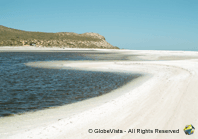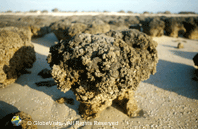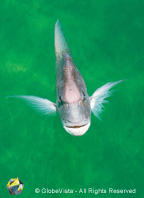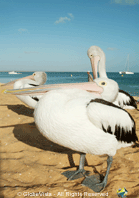Brief History
 Shark Bay is located 870km north of Perth, at the most westerly point of the Australian continent, comprising of a series of peninsulas, inlets and islands.
Shark Bay is located 870km north of Perth, at the most westerly point of the Australian continent, comprising of a series of peninsulas, inlets and islands.
In 1699, William Dampier gave the area the name Shark Bay. The Shark Bay Marine Park covers an area of approximately 748,735 ha or 25,000sqkm with a 1,500km long coastline.
In 1991 the area of Shark Bay was listed as World Heritage Site and is only one of eleven sites in the world to satisfy all four criteria. More history of Shark Bay.
Things You May Not Know About Shark Bay
 When you cross the electric fence to enter Shark Bay you also set off a ‘dog barking’ sensor which is used as a deterrent for would-be foxes etc that may be considering entering the protected reserve.
When you cross the electric fence to enter Shark Bay you also set off a ‘dog barking’ sensor which is used as a deterrent for would-be foxes etc that may be considering entering the protected reserve.
Shark Bay is home to approximately 13% of the world population of dugong.
Shark Bay has the largest reported seagrass meadows in the world (approximately 4,000 sqkm).
In 1772, a Frenchman, Francois St Allouarn, laid formal claim to the territory on behalf of France and then buried two coins and parchment in a bottle.
Guano mining was the first known commercial activity in the Shark Bay area.  Hamelin Pool is home to the oldest living fossil, the Stromatolite. This is one of only two places in the world where living marine stromatolites occur, the other is in the Lee Stocking Island, Bahamas.
Hamelin Pool is home to the oldest living fossil, the Stromatolite. This is one of only two places in the world where living marine stromatolites occur, the other is in the Lee Stocking Island, Bahamas.
Pearling was the biggest industry in the area from the 1850s until the 1940s. The pearls were used for jewellery and the shells for buttons.
Sharkbay is home to the world’s most dangerous stinging fish, the Stonefish.  Shell Beach exists because the cockle shell’s number one predator, the shell grilling gastropods, can not survive in the salty conditions.
Shell Beach exists because the cockle shell’s number one predator, the shell grilling gastropods, can not survive in the salty conditions.
In Useless Loop and Useless Inlet you will find large solar salt works. The salt (sodium chloride) is produced when the ponds are repeatedly flooded with seawater and the water is then evaporated.
Useless Loop was named by Henri De Sauces Freycinet of the Baudin expedition of 1801-1803. The Frenchman gave it the name ‘Havre Inutile’ (Useless Loop) because a large sandbar blocked off any boat from entering the harbour, thus making it useless!
 The Francois Peron National Park at the northern extreme of Peron Peninsula was originally a pastoral/sheep station that relied on artesian bores to supply much-needed water to the livestock.
The Francois Peron National Park at the northern extreme of Peron Peninsula was originally a pastoral/sheep station that relied on artesian bores to supply much-needed water to the livestock.
In August 2007, the wreck of the HMAS Sydney was discovered by Phil Shepherd, off Cape Inscription on the northern end of Dirk Hartog Island, in 150m of water. The 65-year-old mystery finally solved.
